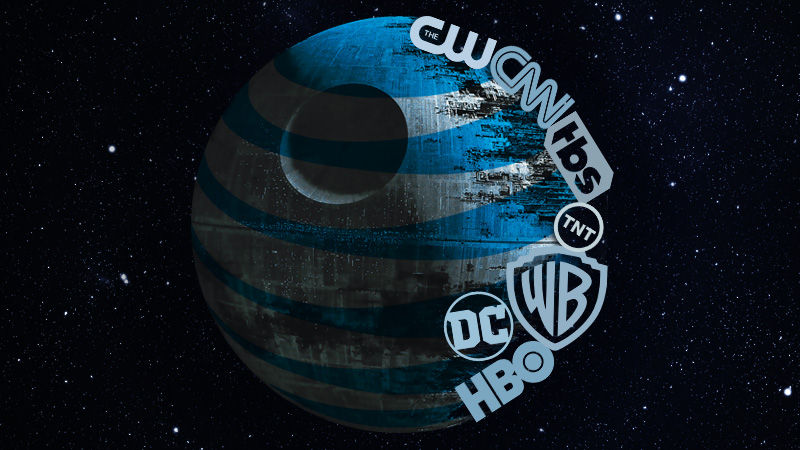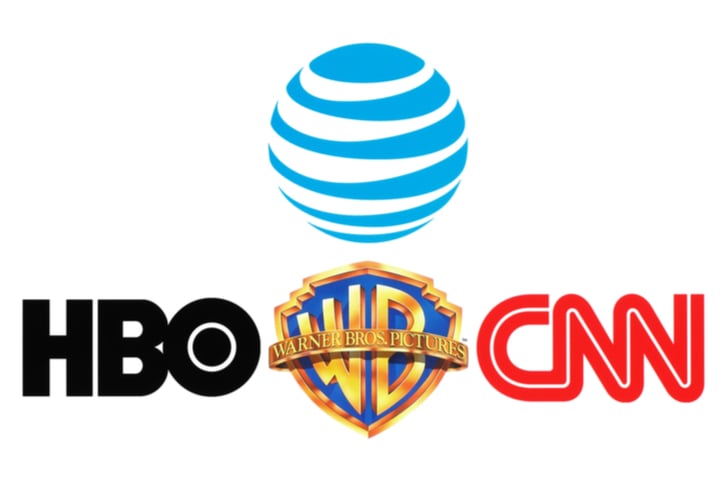AT&T Inc.
 AT&T
Inc. is an American multinational conglomerate holding company headquartered at Whitacre Tower in Downtown Dallas, Texas. It is the world's largest telecommunications
company, the second largest provider of mobile telephoneservices, and the largest provider of fixed telephone services in the United States through AT&T Communications. Since June 14, 2018, it is also the parent company of
mass media conglomerate WarnerMedia, making it the world's largest media and
entertainment company in terms of revenue. As of 2018, AT&T is ranked #9 on the Fortune 500 rankings of the largest United States corporations
by total revenue.
AT&T
Inc. is an American multinational conglomerate holding company headquartered at Whitacre Tower in Downtown Dallas, Texas. It is the world's largest telecommunications
company, the second largest provider of mobile telephoneservices, and the largest provider of fixed telephone services in the United States through AT&T Communications. Since June 14, 2018, it is also the parent company of
mass media conglomerate WarnerMedia, making it the world's largest media and
entertainment company in terms of revenue. As of 2018, AT&T is ranked #9 on the Fortune 500 rankings of the largest United States corporations
by total revenue.
AT&T Inc.
|
|
|
|
|

AT&T's
corporate headquarters in Dallas, Texas
|
|
Formerly
|
·
Southwestern Bell Corporation
(1983–1995)
·
SBC Communications Inc. (1995–2005)
|
Type
|
Public
|
Industry
|
·
Telecommunications
·
Technology
·
Mass media
·
Entertainment
|
Predecessor
|
·
American Telephone and Telegraph Company
·
BellSouth
·
Ameritech
·
Pacific Telesis
·
Southwestern Bell
|
Founded
|
October 5, 1983; 35 years ago
|
Headquarters
|
Whitacre Tower,
Dallas, Texas
,
U.S.
|
Area served
|
Worldwide
|
Key people
|
·
Randall L. Stephenson
·
(chairman, CEO and president)
|
Products
|
·
Satellite television
·
Fixed-line
telephony
·
Mobile
telephony
·
Broadband
·
Digital television
·
Home security
·
IPTV
·
OTT services
·
Network
security
·
Film production
·
Television production
·
Cable
television
·
Pay television
·
Publishing
·
Podcasts
·
Sports management
·
News agency
·
Video games
|
Revenue
|
|
Operating income
|
|
Net income
|
|
Total assets
|
|
Total equity
|
|
Number of employees
|
273,210 (2018)
|
Divisions
|
·
AT&T Communications
·
WarnerMedia
·
AT&T Latin America
·
Xandr
|
Subsidiaries
|
AT&T Corporation
|
Website
|
|
 AT&T
began its history as Southwestern Bell Telephone Company, a subsidiary of the Bell Telephone Company, founded by Alexander Graham Bell in 1880. The Bell Telephone Company evolved
into American Telephone and Telegraph Company in 1885, which
later rebranded as AT&T Corporation. The 1982 United States v. AT&T antitrust lawsuit resulted in the divestiture of
AT&T Corporation's ("Ma Bell") subsidiaries or Regional Bell Operating Companies (RBOCs, or "Baby Bells"), resulting in
several independent companies including Southwestern Bell Corporation; the
latter changed its name to SBC Communications Inc. in 1995. In 2005, SBC
purchased its former parent AT&T Corporation and took on its branding, with
the merged entity naming itself AT&T Inc. and using its iconic logo and
stock-trading symbol. In 2006, AT&T Inc. acquired BellSouth, the last independent Baby Bell company, making their
formerly joint venture Cingular Wireless (which
had acquired AT&T Wireless in 2004) wholly owned and rebranding it as AT&T Mobility.
AT&T
began its history as Southwestern Bell Telephone Company, a subsidiary of the Bell Telephone Company, founded by Alexander Graham Bell in 1880. The Bell Telephone Company evolved
into American Telephone and Telegraph Company in 1885, which
later rebranded as AT&T Corporation. The 1982 United States v. AT&T antitrust lawsuit resulted in the divestiture of
AT&T Corporation's ("Ma Bell") subsidiaries or Regional Bell Operating Companies (RBOCs, or "Baby Bells"), resulting in
several independent companies including Southwestern Bell Corporation; the
latter changed its name to SBC Communications Inc. in 1995. In 2005, SBC
purchased its former parent AT&T Corporation and took on its branding, with
the merged entity naming itself AT&T Inc. and using its iconic logo and
stock-trading symbol. In 2006, AT&T Inc. acquired BellSouth, the last independent Baby Bell company, making their
formerly joint venture Cingular Wireless (which
had acquired AT&T Wireless in 2004) wholly owned and rebranding it as AT&T Mobility.
The
current AT&T reconstitutes much of the former Bell System, and includes ten of the original 22 Bell Operating
Companies along with the original long distance division.
MORE POSTS
History
Origin and growth (1885–1981)
AT&T can trace its origin back to
the original Bell Telephone Company founded by Alexander Graham Bell after his patenting of the telephone. One of that company's
subsidiaries was American Telephone and Telegraph Company(AT&T), established in 1885, which acquired the Bell Company
on December 31, 1899, for legal reasons, leaving AT&T as the main company.
AT&T established a network of subsidiaries in the United States and Canada
that held a government-authorized phone service monopoly, formalized with the Kingsbury Commitment, throughout most of the twentieth century. This monopoly was
known as the Bell System, and during this period,
AT&T was also known by the nickname Ma Bell. For periods of time, the former
AT&T was the world's largest phone company.
Breakup and reformation (1982–2004)
In 1982, U.S. regulators broke up the AT&T
monopoly, requiring AT&T to divest its
regional subsidiaries and turning them each into individual companies. These
new companies were known as Regional Bell
Operating Companies, or more informally, Baby Bells. AT&T continued to operate
long distance services, but as a result of this breakup, faced competition from
new competitors such as MCI and Sprint.
Southwestern Bell was one of the
companies created by the breakup of AT&T Corp. The architect of divestiture
for Southwestern Bell was Robert G. Pope. The company soon started a series of
acquisitions. This includes the 1987 acquisition of Metromedia mobile business and the
acquisition of several cable companies in the early 1990s. In the later half of
the 1990s, the company acquired several other telecommunications companies,
including some Baby Bells, while selling its cable business. During this time,
the company changed its name to SBC Communications. By 1998, the company was in
the top 15 of the Fortune 500, and by 1999 the company was part of
the Dow Jones Industrial
Average (lasting through 2015).
Purchase of former parent and acquisitions (2005–2014)
In 2005, SBC purchased AT&T for
$16 billion. After this purchase, SBC adopted the better-known AT&T name
and brand, with the original AT&T Corp. still existing as the long-distance
landline subsidiary of the merged company. The current AT&T claims the
original AT&T Corp.'s history (dating to 1885) as its own, though its
corporate structure only dates from 1983. It also retains SBC's pre-2005
stock price history, and all regulatory filings prior to 2005 are for Southwestern
Bell/SBC, not AT&T Corp.
In September 2013, AT&T Inc.
announced it would expand into Latin America through a collaboration
with América Móvil. In December 2013, AT&T
announced plans to sell its Connecticut wireline operations to
Stamford-based Frontier Communications.
Recent developments (2014–present)
AT&T purchased the Mexican
carrier Iusacell in late 2014, and two months later purchased
the Mexican wireless business of NII Holdings, merging the two companies to
create AT&T Mexico.
 In July 2015, AT&T
purchased DirecTV for $48.5 billion, or $67.1 billion including assumed
debt, subject to certain conditions. AT&T subsequently announced
plans to converge its existing U-verse home internet and IPTV brands with
DirecTV, to create AT&T Entertainment.
In July 2015, AT&T
purchased DirecTV for $48.5 billion, or $67.1 billion including assumed
debt, subject to certain conditions. AT&T subsequently announced
plans to converge its existing U-verse home internet and IPTV brands with
DirecTV, to create AT&T Entertainment.
In an effort to increase its media
holdings, on October 22, 2016, AT&T
announced a deal to buy Time Warner for $108.7 billion.
AT&T also owns approximately a 2%
stake in Canadian-domiciled entertainment company Lionsgate.
On July 13, 2017, it was reported
that AT&T would introduce a cloud-based DVR streaming
service as part of its effort to create a unified platform across DirecTV and its DirecTV Now streaming service, with U-verse to be added soon. In October 2018, it was
announced that the service Is set to launch in 2019
On September 12, 2017, it was
reported that AT&T planned to launch a new cable TV-like service for
delivery over-the-top over its own or a competitor's broadband network sometime
next year.
On November 20, 2017, Assistant
Attorney General Makan Delrahim filed
a lawsuit for the United States Department of Justice Antitrust Division to block the merger with Time Warner, saying it "will
harm competition, result in higher bills for consumers and less
innovation." In order for AT&T to fully
acquire Time Warner, the Department of Justice stated that the company must
divest either DirecTV or Turner Broadcasting
System.
As of 2017, AT&T is the world's
largest telecommunications company. AT&T is also the second
largest provider of mobile telephone services and
the largest provider of fixed telephone services in
the United States.
On March 7, 2018, the company
prepared to sell a minority stake of DirecTV Latin America through an IPO, creating a new holding company for those
assets named Vrio Corp. However, on April 18, 2018,
just a day before the public debut of Vrio, AT&T canceled the IPO due to
market conditions.

On June 12, 2018, AT&T was given
permission by U.S. District Court Judge Richard J. Leon to go ahead
with its $85 billion deal for Time Warner. The DOJ had attempted to stop the
merger fearing it would harm competition. The merger closed two days
after, becoming a wholly owned subsidiary and division of AT&T with a new
name, WarnerMedia, announced the
next day.
Three months after completing the
acquisition, AT&T reorganized into four main units: Communications,
including consumer and business wireline telephony, AT&T Mobility, and consumer
entertainment video services; WarnerMedia, including Turner Broadcasting cable television networks, Warner Bros. film and television production,
and HBO; AT&T Latin America, consisting of
wireless service in Mexico and video in Latin America and the Caribbean under the
Vrio brand; and Advertising and Analytics, since renamed Xandr.
AT&T
Latin America
AT&T
Latin America, LLC
|
|
Formerly
|
AT&T International, Inc. (2017-2018)
|
Type
|
Division
|
Industry
|
Telecommunication
|
Founded
|
2017; 2 years ago
|
Headquarters
|
Dallas, Texas,United States
|
Area served
|
MexicoSouth America
|
Key people
|
Lori Lee
(CEO)
|
Products
|
Wireless
Satellite television
|
Revenue
|
US$8
billion (2017)
|
Parent
|
AT&T
|
Subsidiaries
|
AT&T Mexico
Vrio
|
Website
|
|
AT&T Latin America (formerly AT&T
International, Inc.) is a wholly owned division of AT&T which operates
in Mexicoand 11 countries in South America.
its Amazing
ReplyDelete